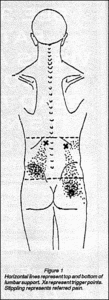Several years ago, a young woman consulted me for severely sensitive skin from her waist down. This symptom had appeared a few hours after she climbed out of bed and bent over to stretch her low back.
As is my custom, I palpated the muscles that classically refer to her areas of complaint. Several irritable trigger points (TPs) infested the muscles, and when I pressed them, her pain flared. She then told me that after wearing the support for a couple of hours, her lower back began to ache. The aching was tolerable, though, so she left the support on. The support had compressed and activated dormant TPs in the underlying myofascia, like a purse strap activates TPs where it cuts into the crest of a trapezius.2
A few minutes of ultrasound focused into the TPs stopped her pain. I advised her, "Wear the support only when it's imperative that you sit or stand for more than brief periods." And in case the TPs began referring again, I taught her how to desensitize them.
After this experience, I watched other patients to whom I gave lumbar supports. In some cases, the supports activated the TPs the way they had in the young woman. Each of these patients had active TPs in the muscles that make up the fleshy walls of the lateral and posterior torso. (See Figure 1)
Lumbar supports can be a valuable adjunct to the protective muscle contractions that accompany many spinal conditions.3 But as I looked back over the years I'd given patients lumbar supports, I realized that I should have screened patients for TPs likely to be activated by the support.
Now before giving a patient a lumbar support, I palpate the muscles the support will squeeze. When a patient's muscles harbor irritable TPs, I give what has become standard advice: "Use the support only when the benefits from wearing it are worth the myofascial pain that it may induce." I desensitize potentially troublesome TPs before the patient straps on the support; this reduces the risk of the support stimulating myofascial pain.
I tell the patient, "Test how tightly you can wear the support without pain. If it causes moderate pain, have someone massage the spots (which I marked with indelible ink) and then soothe them with moist heat. If the support causes severe pain, stop wearing it even if you have to stay recumbent most of the time."
Patients like the young woman, seldom blame the support for aggravating their condition. Some of them parrot her statement about symptoms getting worse before getting better. Or they say things like, "I guess this aching is just part of having a herniated disk." I dispel these erroneous notions. "The support is the culpret," I explain. "But when you understand how to use it properly, it can help you get well." In the meantime, the other symptoms patients suffer will be a pure reflection of their primary problem, unclouded by iatrogenic myofascial pain.

References
- Cailliet, R.: Low Back Pain Syndrome. F.A. Davis, Philadelphia, 1981, p. 125.
- Travell, J.G. and Simons, D.G.: Myofascial Pain and Dysfunction: The Trigger Point Manual. Baltimore, Williams and Wilkins, 1983, p. 198.
- Lowe, J.C.: The lumbar corset: an adjunct to protective constrictions. Anabolism: Journal of Preventive Medicine, 6:(2)5, 1987.
John C. Lowe, M.A., D.C.
Houston, Texas
Click here for previous articles by John Lowe, MA, DC.





